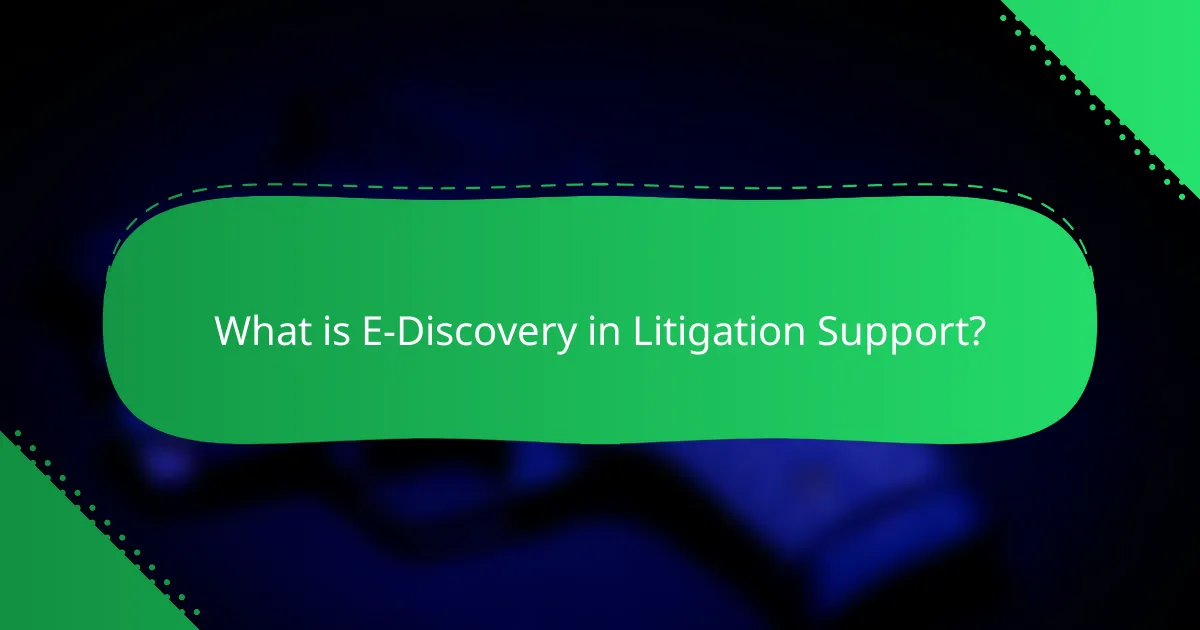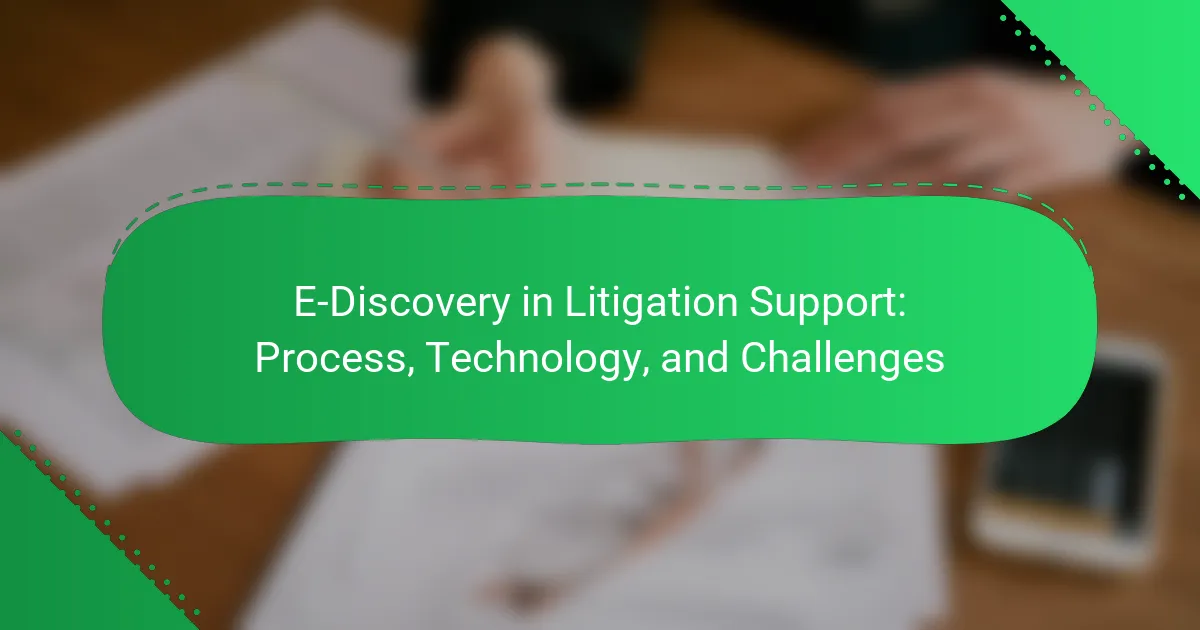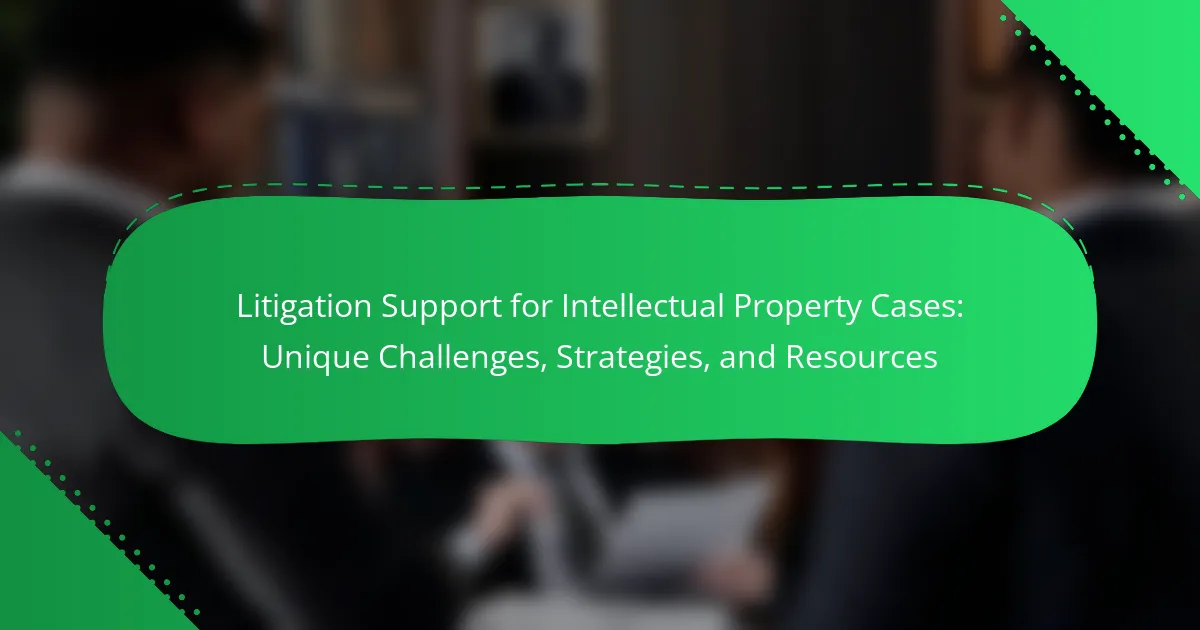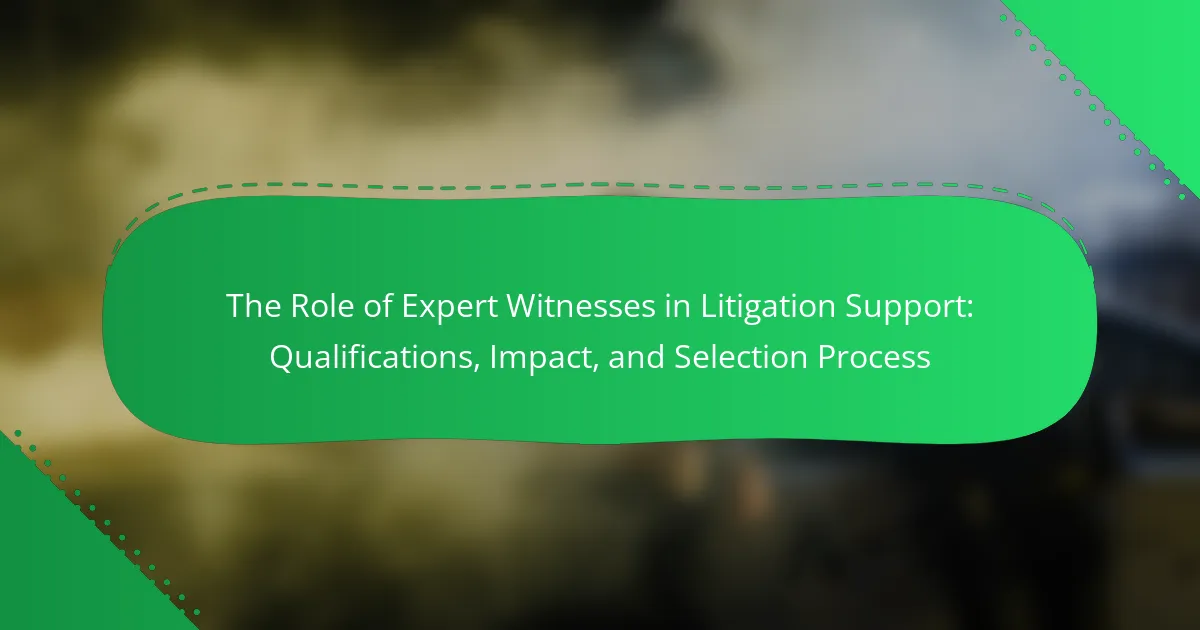E-Discovery in litigation support refers to the process of identifying, collecting, and reviewing electronically stored information (ESI) relevant to legal cases. This article provides an overview of the technologies and methodologies involved in E-Discovery, including data processing tools, document review platforms, predictive coding, and optical character recognition (OCR). It also addresses common challenges faced during the E-Discovery process, such as data volume, diversity, legal compliance, and security concerns. The impact of effective E-Discovery on litigation outcomes is highlighted, emphasizing its significance in revealing critical evidence while managing costs and timelines.

What is E-Discovery in Litigation Support?
E-Discovery in litigation support refers to the process of identifying, collecting, and reviewing electronically stored information (ESI) for legal cases. It involves various technologies and methodologies to manage digital evidence. E-Discovery is essential for ensuring that relevant data is available for legal proceedings. The process can include emails, documents, databases, and social media content. Legal teams often use specialized software to streamline the review and analysis of this information. The Federal Rules of Civil Procedure govern the use of E-Discovery in the United States. Effective E-Discovery can significantly impact the outcome of litigation by revealing critical evidence.
How does E-Discovery fit into the litigation process?
E-Discovery is a crucial component of the litigation process. It involves the identification, collection, and analysis of electronic data relevant to a legal case. This process ensures that parties can access pertinent information that may influence the outcome of the litigation. E-Discovery helps in uncovering evidence stored in emails, documents, and databases. The Federal Rules of Civil Procedure govern E-Discovery practices in the United States. Compliance with these rules is essential for maintaining the integrity of the legal process. Effective E-Discovery can significantly reduce litigation costs and timeframes. It also enhances the ability to present compelling evidence during trials.
What are the key stages of the E-Discovery process?
The key stages of the E-Discovery process are identification, preservation, collection, processing, review, analysis, and production. Identification involves determining what data is relevant to the case. Preservation ensures that relevant data is protected from alteration or destruction. Collection refers to gathering the identified data from various sources. Processing involves organizing and preparing the data for review. Review is the examination of the data to find pertinent information. Analysis includes assessing the data for insights and patterns. Finally, production is the delivery of relevant information to the requesting party. Each stage plays a critical role in ensuring a thorough and effective E-Discovery process.
What roles do legal teams play in E-Discovery?
Legal teams play crucial roles in E-Discovery. They manage the identification, preservation, collection, and review of electronically stored information (ESI). Legal teams ensure compliance with legal and regulatory requirements during E-Discovery. They collaborate with IT specialists to implement technology solutions for data management.
Additionally, legal teams develop strategies for document review and production. They assess the relevance and privilege of documents in the E-Discovery process. Legal teams also engage in negotiations regarding the scope of E-Discovery with opposing parties. Their expertise is essential in minimizing risks and costs associated with E-Discovery.
Why is E-Discovery important in modern litigation?
E-Discovery is important in modern litigation because it enables the identification, collection, and analysis of electronic data relevant to a case. This process is crucial as most information is now created and stored digitally. E-Discovery helps legal teams uncover evidence that may be critical for case strategy. It also ensures compliance with legal obligations regarding data preservation and disclosure. According to a study by the American Bar Association, 97% of lawyers believe that E-Discovery is essential for effective litigation. Additionally, E-Discovery can significantly reduce the time and costs associated with traditional discovery methods. By streamlining the evidence-gathering process, it enhances the overall efficiency of litigation.
How does E-Discovery impact case outcomes?
E-Discovery significantly impacts case outcomes by influencing the evidence available for litigation. It allows parties to collect, review, and produce electronic data relevant to a case. This process can reveal critical information that may support or undermine a party’s claims. For instance, a study by the RAND Corporation found that effective E-Discovery can reduce litigation costs by up to 30%. Additionally, timely access to electronic evidence can expedite case resolution. In many instances, the quality of E-Discovery can determine the strength of legal arguments presented in court. Thus, E-Discovery plays a crucial role in shaping the trajectory and results of legal disputes.
What legal obligations do organizations have regarding E-Discovery?
Organizations have legal obligations to preserve, collect, review, and produce electronically stored information (ESI) relevant to litigation. These obligations arise from various laws and regulations, including the Federal Rules of Civil Procedure in the United States. Organizations must implement a legal hold process to prevent the destruction of relevant data once litigation is anticipated. Failure to comply can result in sanctions, including fines or adverse inference rulings. Courts expect organizations to act reasonably and in good faith when handling ESI. This includes maintaining proper data management practices. Clear documentation of the E-Discovery process is essential for demonstrating compliance.

What technologies are used in E-Discovery?
E-Discovery utilizes various technologies to manage electronic data for legal proceedings. Key technologies include data processing tools that organize and filter large volumes of information. Document review platforms facilitate the examination of relevant documents by legal teams. Predictive coding and machine learning assist in identifying pertinent data efficiently. Optical character recognition (OCR) converts scanned documents into searchable text. Additionally, cloud computing enables secure storage and access to data across multiple locations. These technologies streamline the E-Discovery process, improving accuracy and reducing timeframes.
How do E-Discovery tools facilitate data collection?
E-Discovery tools facilitate data collection by automating the process of identifying, collecting, and preserving electronically stored information (ESI). These tools streamline the search for relevant data across various platforms and formats. They can process large volumes of data quickly, reducing the time and effort required for manual collection. E-Discovery tools also ensure compliance with legal standards and protocols during data collection. Features like keyword searching, data filtering, and tagging enhance the accuracy of identifying pertinent information. Additionally, they maintain data integrity and chain of custody, which are critical in legal proceedings. By employing advanced algorithms, E-Discovery tools can uncover hidden or less obvious data, improving the comprehensiveness of the collection process.
What types of data can E-Discovery tools process?
E-Discovery tools can process various types of data including emails, documents, and databases. They also handle social media content, instant messages, and audio/video files. Furthermore, E-Discovery tools can analyze metadata associated with these data types. This capability is essential for identifying relevant information during legal investigations. The ability to process structured and unstructured data enhances the effectiveness of the E-Discovery process. According to a report by the American Bar Association, over 90% of data generated today is unstructured, highlighting the importance of these tools in legal contexts.
How does artificial intelligence enhance E-Discovery?
Artificial intelligence enhances E-Discovery by automating data analysis and improving accuracy. AI algorithms can quickly process vast amounts of electronic data. This capability reduces the time and cost associated with manual review. Machine learning models can identify relevant documents with higher precision. According to a study by the RAND Corporation, AI can reduce document review costs by up to 70%. AI tools also facilitate predictive coding, which ranks documents based on relevance. This leads to more efficient workflows and better case outcomes. Overall, AI integration transforms E-Discovery into a faster, more reliable process.
What are the challenges associated with E-Discovery technology?
E-Discovery technology faces several challenges. One major challenge is the sheer volume of data that needs to be processed. Organizations often deal with terabytes of information across multiple platforms. This can lead to increased costs and time required for data management. Another challenge is ensuring data security and privacy compliance. Sensitive information must be protected during the e-discovery process. Additionally, the technology can struggle with data formats and compatibility issues. Different file types and sources may complicate the extraction and analysis process. Furthermore, there is often a lack of skilled personnel familiar with e-discovery tools. This skill gap can hinder effective implementation and use of the technology. Lastly, the evolving legal landscape presents challenges. Regulations regarding data handling and e-discovery are continuously changing, requiring ongoing adaptation.
What data privacy concerns arise during E-Discovery?
Data privacy concerns during E-Discovery include unauthorized access to sensitive information. The collection of electronic data may involve personal data protected under laws like GDPR or HIPAA. There is a risk of exposing confidential communications during the review process. Inadequate data handling procedures can lead to breaches of privacy. The potential for data mismanagement increases during large-scale data processing. Compliance with legal and regulatory requirements is critical to mitigate risks. Organizations must implement strict access controls and data encryption. Failure to address these concerns can result in legal penalties and reputational damage.
How do organizations manage the costs of E-Discovery technology?
Organizations manage the costs of E-Discovery technology through strategic planning and resource allocation. They assess their specific needs to choose appropriate tools and services. Many organizations implement cost-effective solutions like cloud-based E-Discovery platforms. This approach reduces the need for extensive hardware investments. Organizations also train staff to optimize the use of E-Discovery tools. By doing so, they minimize reliance on external consultants. Furthermore, they often conduct regular audits to identify areas for cost savings. According to a report by the Legal Technology Resource Center, effective cost management in E-Discovery can reduce expenses by up to 30%.

What are the common challenges in E-Discovery?
Common challenges in E-Discovery include data volume, data diversity, and legal compliance. The sheer volume of data generated can overwhelm legal teams. Diverse data types, such as emails, documents, and social media, complicate the review process. Legal compliance issues arise from varying regulations across jurisdictions. Additionally, ensuring data security during the E-Discovery process is critical. The cost of E-Discovery can also escalate quickly, impacting budgets. Moreover, the need for skilled personnel to manage E-Discovery adds to the challenges. Finally, timeline pressures often hinder thorough reviews and analyses.
How can organizations address the challenges of E-Discovery?
Organizations can address the challenges of E-Discovery by implementing robust data management strategies. These strategies include establishing clear policies for data retention and destruction. Regular training for staff on E-Discovery processes is essential. Utilizing advanced technology for data collection and analysis can streamline the process. Automated tools can help in identifying relevant documents efficiently. Organizations should also collaborate with legal experts to ensure compliance with regulations. Regular audits of E-Discovery processes can identify areas for improvement. By adopting these measures, organizations can mitigate risks and reduce costs associated with E-Discovery.
What best practices can improve E-Discovery efficiency?
Implementing best practices such as early case assessment, clear data management protocols, and leveraging technology can significantly improve E-Discovery efficiency. Early case assessment allows teams to identify relevant data and streamline the review process. Establishing clear data management protocols ensures that data is organized and easily accessible. Utilizing advanced technology, like artificial intelligence and machine learning, enhances the speed and accuracy of document review. According to a study by the RAND Corporation, effective use of technology can reduce E-Discovery costs by up to 50%. Regular training for legal teams on E-Discovery tools further increases efficiency by minimizing errors and improving workflow.
How can teams ensure compliance during E-Discovery?
Teams can ensure compliance during E-Discovery by implementing a structured process. This includes establishing clear policies and protocols for data collection. Teams should also provide training on compliance requirements for all personnel involved. Regular audits can help identify and address compliance gaps. Utilizing reliable E-Discovery tools ensures accurate data handling. Documenting all procedures and communications is essential for accountability. These practices align with legal standards and help mitigate risks. Compliance is critical to avoid sanctions and protect sensitive information.
What practical tips can enhance E-Discovery processes?
Implementing a clear E-Discovery plan enhances the process significantly. Establish clear protocols for data collection and preservation. Utilize technology-assisted review tools to expedite document review. Train staff on E-Discovery best practices to ensure compliance. Regularly update and audit E-Discovery processes to adapt to legal changes. Collaborate with legal teams to define relevant data early in the process. Maintain open communication with all stakeholders to streamline workflows. These strategies lead to increased efficiency and reduced costs in E-Discovery.
How can effective communication improve E-Discovery outcomes?
Effective communication can significantly improve E-Discovery outcomes by ensuring clarity and reducing misunderstandings. Clear communication among legal teams helps define objectives and expectations. This alignment enhances the accuracy of data collection and analysis. Effective dialogue with clients and stakeholders also facilitates the identification of relevant information. Regular updates can keep all parties informed about progress and challenges. Furthermore, transparent communication fosters collaboration, leading to more efficient problem-solving. Studies show that organizations with strong communication practices are 25% more productive. Therefore, effective communication is crucial for successful E-Discovery processes.
What resources are available for E-Discovery training and support?
Resources available for E-Discovery training and support include online courses, workshops, and certification programs. Organizations like the Association of Certified E-Discovery Specialists (ACEDS) offer comprehensive training. Various universities provide specialized courses in E-Discovery as part of legal studies. Additionally, many software vendors, such as Relativity and Logikcull, offer training on their platforms. Webinars and industry conferences also serve as valuable resources for ongoing education. These resources help legal professionals stay updated on best practices and emerging technologies in E-Discovery.
E-Discovery in litigation support is the process of identifying, collecting, and reviewing electronically stored information (ESI) relevant to legal cases. This article covers the key stages of the E-Discovery process, the roles of legal teams, and the importance of E-Discovery in modern litigation. It also explores the technologies used, challenges faced, and best practices for improving efficiency and ensuring compliance. Additionally, the article highlights the impact of E-Discovery on case outcomes and the legal obligations organizations have regarding data management during litigation.



